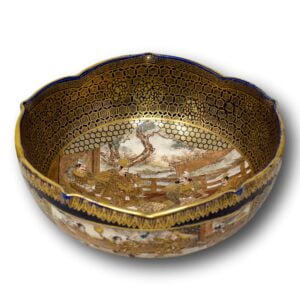Description
Meiji Period 1868-1912
From our Japanese Satsuma collection, we are delighted to offer this Japanese Satsuma Vase by Ryozan.
The vase is of tapered form with a tightly pinched neck and flared top rim. Its decoration includes a striking upper band of one thousand butterflies interspersed with four circular roundels of children at play. Below, four large continuous scenes are finely painted: lively processional marches, a flowing river landscape, and elegant groups of seated geishas.
The underside of the vase is signed Ryozan 良山 and dates to the Meiji Period (1868–1912), circa 1895.
Provenance
Sold previously by Jacksons Antique into a private Satsuma collection and repurchased in late 2024 in part exchange.
Ryozan 良山
Ryozan 良山 (different to the Yasuda Company Okamoto Ryozan 亮山) worked under the famous maker Meizan as an artist and produced good quality satsuma wear.
MEIJI PERIOD (1868-1912)
The Meiji era marked Japan’s transformation into a modern nation and a golden age of decorative arts. With the end of samurai rule and Japan’s opening to the West, artisans produced works of exceptional quality for both domestic and international audiences. Supported by the government through world fairs and Imperial commissions, Japanese lacquerware, cloisonné, satsuma ceramics, bronzes, and ivory carvings reached collectors worldwide. Many leading artists of the time, including Makuzu Kozan and Namikawa Yasuyuki, were honoured as Imperial Household Artists, ensuring the Meiji period remains one of the most celebrated eras of Japanese art.
For further information please see our article Japanese Meiji Period: Art, Collecting, and Cultural Transformation.
SATSUMA WARE
Satsuma ware originated in southern Kyūshū around 1600 and developed into one of Japan’s most recognisable ceramics. Early Ko-Satsuma pieces were rustic, dark-clay wares made for everyday use, while the later Kyō-Satsuma style became famous worldwide during the Meiji period.
Characterised by ivory crackled glaze, delicate overglaze enamels, and lavish gilding, export Satsuma appealed strongly to Western collectors. Designs often feature landscapes, flowers, figures, and scenes from Japanese life and mythology. Renowned artists such as Yabu Meizan, Ryozan, and the Kinkōzan workshop produced some of the finest examples, which remain highly sought after today. Genuine Satsuma can often be identified by the Shimazu crest, artist signatures, or the mark “Dai Nippon” used during the Meiji era.
For further information on the history of Satsuma Wear please see our article Japanese Satsuma Ware.
Measurements
12.5cm High x 7.5cm Diameter (4.9 x 2.95 inches)
Condition
Excellent, No damage and No restoration
With every purchase from Jacksons Antique, you will receive our latest product guide, certificate of authenticity, full tracking information so you can monitor your shipment from start to finish and our personal no-hassle, money-back policy giving you that extra confidence when purchasing. Don’t forget to sign up to our free monthly newsletter for 10% off your first online purchase.































